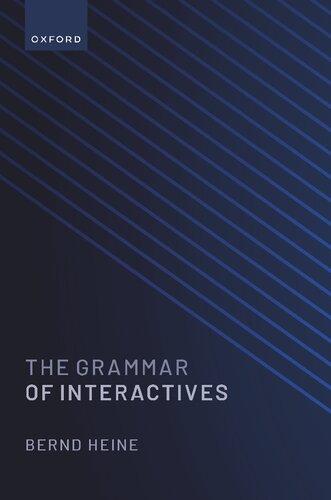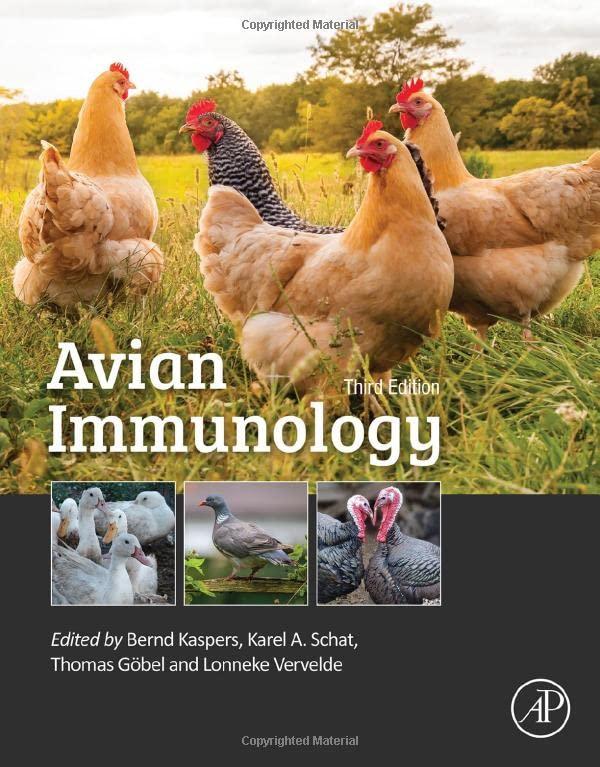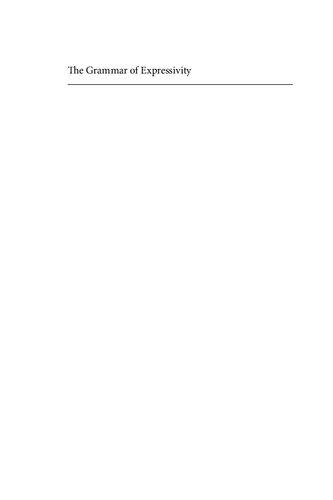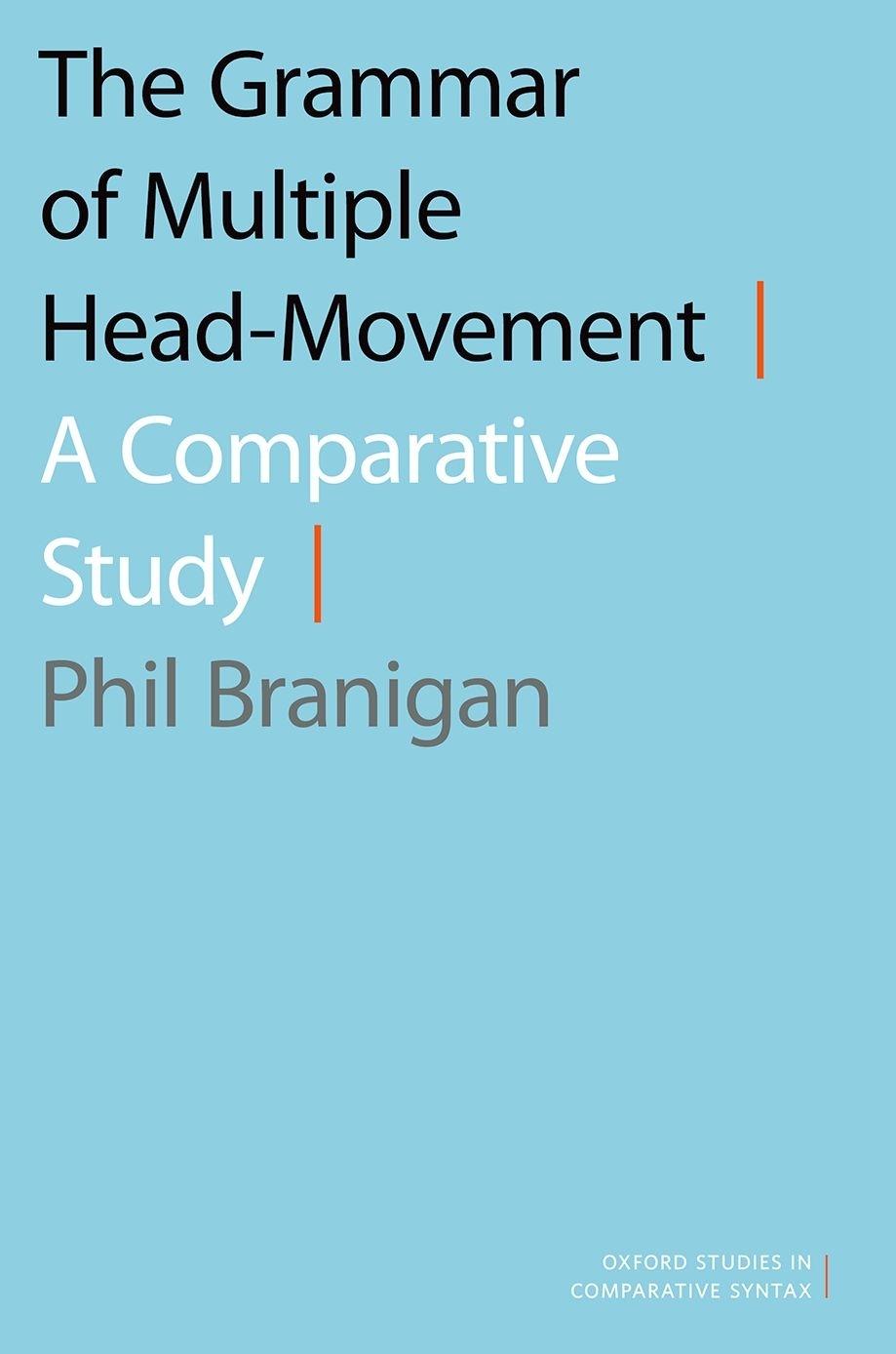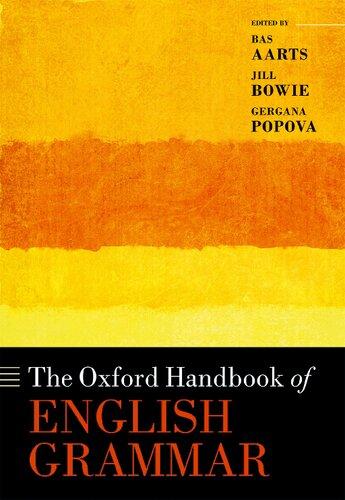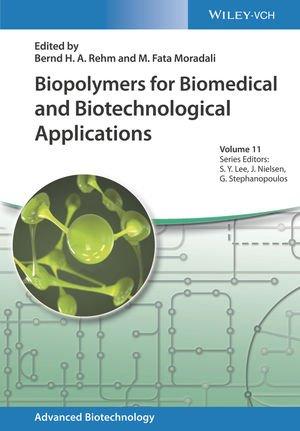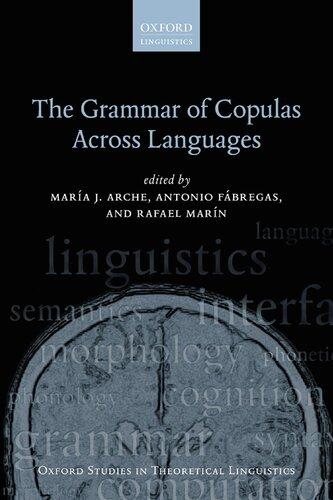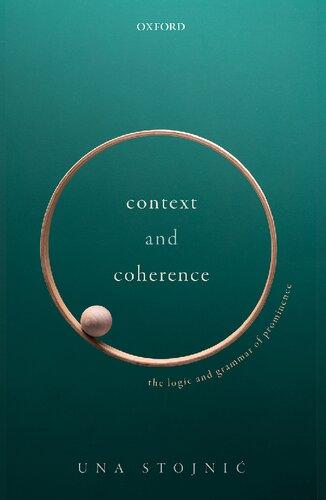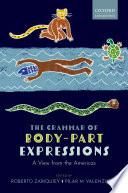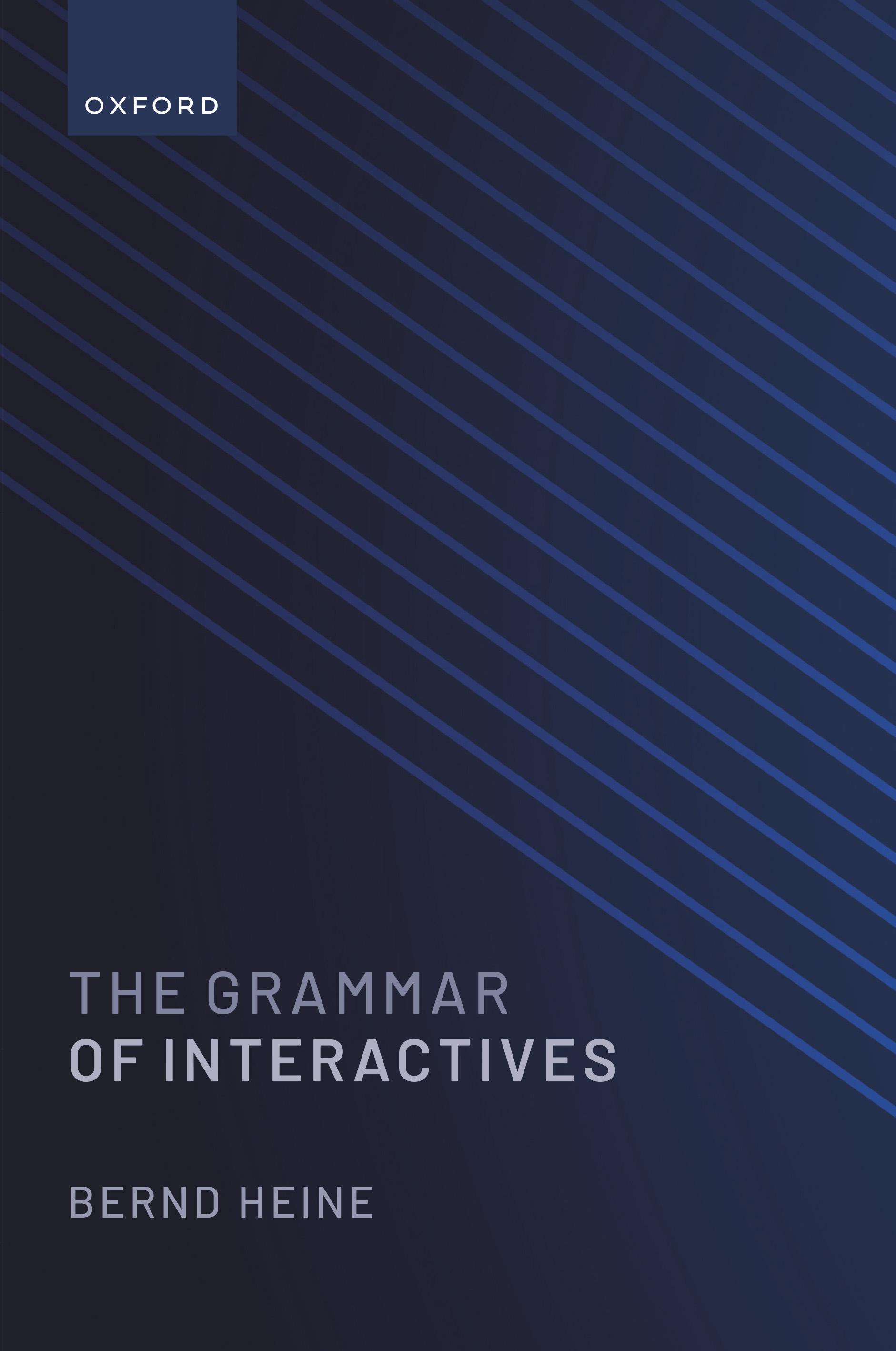Listoffiguresandtables
Figures
4.1.Anetworkofgrammaticalizationchainslinkingtypesofinteractives
5.1.ClassificationoftheC-unitsandinsertsofBiberetal.(1999)
Tables
1.1.Themaintypesofinteractives
1.2.ExamplesofEnglishinteractivesintheleftperipheryslotofanutterance 19
1.3.TonaldistinctionsintheGermaninteractives ach, hm,and oje 24
1.4.Englishinteractivesandnegation
1.5.UnusualphonologicalfeaturesinEnglishtypesofinteractives
1.6.ThemaintypesofinteractiveswithEnglishexamples
2.1.TwokindsofmeaningofinteractivesaccordingtoKaplan(1999)
2.2.Methods,functions,anddisplaysusedincommunication 69
2.3.Threebasicmodesofrepresentinginformationfordiscourseprocessing
2.4.TypesofEnglishinteractives
2.5.ApproximateparaphrasesoftheinteractivesinTable2.4
2.6.PrototypicalargumentstructureoftheinteractivesinTable2.5
3.1.Mainfunctionsofthetentypesofinteractives
3.2.Correspondencesbetweeninserts(Biberetal.1999)andinteractives 110
3.3.Correspondingformsoftheattentionsignal*hey indifferentlanguages 117
3.4.FunctionsexpressedbydirectivesintwoAustralianlanguages 124
3.5.(Logudorese)Sardiniandirectives 125
3.6.Suppletiveimperativestemsin!Xun(E1dialect,Kx’afamily) 126
3.7.PartialsuppletisminSwahiliimperativeforms 126
3.8.AspectualfeaturesofJapaneseadverbialideophones(‘mimetics’) 151
3.9.Themaindiscourseconstructionsforpresentingideophones 153
3.10.IdeophoneconstructionsinSiwu 157
3.11.Correlationsinsoundsymbolismobservedinideophones
3.12.Iconicsound–meaningdistinctionsinWestAfricanlanguages 166
3.13.Englishformsthathavebeenclassifiedasprimaryandsecondary interjections
3.14.TypesofEnglishinteractivesshowingaprimaryvs.secondaryform distinction
3.15.Structuralschemaimposedbyother-initiatedrepair(OIR)markersin conversations
3.16.Asampleof‘other-initiatedrepairmarkers’
3.17.DegreesofpolitenessinKoreanresponsesignalsbasedonspeechlevels
3.18.TonologicalvariantsoftheGermanresponsesignal hm
3.19.TypesofEnglishvocatives
3.20.ReductionofsomeItalianfirstnames
3.21.ReductionofsomeCatalanfirstnames
3.22.ReductionofsomeZulunouns(Bantu,Niger-Congo)
3.23.Extensionsoftheterm ı´iyá ‘mother’inDatooga(SouthernNilotic, Nilo-Saharan)
3.24.AnimaldirectivesfordeicticmotioninZargulla(Omotic,Afroasiatic)
3.25.FunctionsofanimaldirectivesformulesinAytHadiddu(Berber,Afroasiatic)
3.26.AnimaldirectivesinManambu(Ndufamily)
3.27.ClassesofanimaldirectivesinArusaMaasai(EasternNilotic,Nilo-Saharan)
3.28.FromanimaldirectivetoverbinMuna(Malayo-Polynesian,Austronesian)
3.29.NurserytermsderivedfromanimaldirectivesinAytHadiddu(Berber, Afroasiatic)
3.30.Distinguishinggrammaticalfeaturesofinteractives
4.1.CooptationofsomeideophonesfromverbsinSwahili(Bantu,Niger-Congo)
4.2.CooptationofideophonesfromverbsinMwera(Bantu,Niger-Congo)
4.3.Theparametersofgrammaticalization
4.4.Hypothesisonthedevelopmentofsomeinteractivestowardstextanchoring
4.5.Fromvocativetodiscoursemarker
4.6.Unidirectionalityinargumentdevelopment
4.7.Englishexamplesofcamouflaging
4.8.Germanexamplesofcamouflaging
4.9.Theinitialandfinalstagestobeexpectedinthegrammaticalizationof ideophones
4.10.Fromideophonetoverb,selectedexamples
4.11.FromideophonetonouninSouthernSotho(Bantu,Niger-Congo)
5.1.‘Interjections’distinguishedbyBloomfield([1933]1962)
5.2.‘Interjections’distinguishedbyLeechetal.(1982)
5.3.‘Discoursemarkers’distinguishedbyZwicky(1985)
5.4.‘Pragmaticmarkers’distinguishedbyFraser(1990;1999)qualifyingas interactives
5.5.‘Interjections’distinguishedbyNorrick(2009)
5.6.Classesof‘interjections’distinguishedbyAmekaandWilkins(2006)
5.7.Korean‘discourseadverbials’distinguishedbySohn(1999)
5.8.Wampis‘interjections’distinguishedbyPeña(2015)
5.9.Kisi‘interjections’distinguishedbyChilds(1995)
5.10.Zuluʽinterjectives’distinguishedbyDoke([1927]1988)
5.11.Thompsonʽexpletives’distinguishedbyThompsonandThompson(1992)
5.12.EnglishinsertsdistinguishedbyBiberetal.(1999)
5.13.Englishexamplesofformulaictheticals
5.14.Sentencegrammarvs.interactivegrammarinaspeechsampleofan English-speakingaphasicpatient
5.15.Somedistinguishingfeaturesassociatedwithprocessesofreasoningand judgment
5.16.Dual-processframeworksrelatingmoststronglytointeractivegrammar
6.1.ExamplesofEnglishinteractivesintheleftperipheryslotofanutterance
6.2.ExamplesofEnglishprimaryinteractives
7.1.Featuresprototypicallydistinguishingsentencegrammarfrominteractive grammar
7.2.ExampleofanopeningsectioninEnglishtelephoneconversations
Interactives
Oneshortinterjectionmaybemorepowerful,moretothepoint,more eloquentthanalongspeech.Infact,interjections,togetherwithgestures,themovementsofthemusclesofthemouth,andtheeye,would bequitesufficientforallpurposeswhichlanguageanswerswiththe majorityofmankind.
(MaxMu¨ller1861:410)
1.1 Introduction
Inmanymonographsoflinguisticsaviewisexpressedorimpliedthatisdescribed succinctlyby Givón(1984) inthefollowingway:
Mostlanguagesdisplaythismixed-bagcategorywithexpressionssuchas‘yes’,‘no’, ‘hey’,‘oh’,‘hi’,‘wow’,‘ouch’,etc.ortheirfunctionalequivalents.Itisnotaunified categoryfunctionally,morphologicallyorsyntacticallyanditishighlylanguage specific.
(Givón1984:84)¹
Thegoalofthepresentstudyistotakeissuewiththisview.² Itisarguedthatthere isinfactsuchacategoryandratherthanbeinga‘mixedbag’,itcanbedescribed acrosslanguagesasagrammaticalcategoryofitsown.Thiscategoryincludes butisnotrestrictedtotheitemsmentionedbyGivón,whicharereferredtohere summarilyasinteractiveformsor,inshort,as interactives. ConsiderthefollowingconversationthattookplaceinTjwao,alanguage spokeninwesternZimbabwe.
(1)Tjwao(Khoe(‘CentralKhoisan’); Andrason,Fehn,andPhiri2020:14,(17))
A: Yii!
B: A-a!
A: Yee!
B: Ehe!
¹ AmoredifferentiatedviewisfoundintherevisededitionofGivón’sintroductiontosyntax(Givón 2001:102).
² Throughoutthisbook,interactivesareprintedinbold.
TheGrammarofInteractives.BerndHeine,OxfordUniversityPress. ©BerndHeine(2023).DOI:10.1093/oso/9780192871497.003.0001
Theconversationconsistsentirelyofinteractives,thatis,ofthekindofexpressions mentionedbyGivón,called‘interjections’bytheauthorsof(1).Theconversation beginswithpersonAmeetingpersonB.AcallsB,usingtheattentionsignal yii. Hearingthis,Bexpresseshissurprisebymeansoftheemotiveinterjection a-a. ³ Subsequently,Aproducestheinterjection yee tovoicehisexcitementandhappinessaboutmeetingB.SpeakerBexperiencesthesamefeelingandexpressesthis bymeansoftheresponsesignal ehe!. ⁴
Examplesofthekindillustratedin(1)arenotisolatedcases.MovingfromAfrica toAustralia,casessuchastheonein(2)canbefound,onceagainconsisting entirelyofinteractives.Theexcerptofaconversationin(2)istakenfromtheMayalilanguageofWesternArnhemLand.Itcontainstwodirectives(boi!, njudj!)and twoinstancesoftheinterjection njonj-njonj!.
(2)Mayali(Gunwinyguan,Arnhem; Evans1992:227,(3))
A: Boi!
Hey,comehere!
[Oldwomantoyouth:]‘Hey,comehere!’[Oldwomanholdsupbaby]
B: Njonj-njonj!
Njudj! Njonj-njonj!
Whatalittlesweetheart!Blowyournose!Whatalittlesweetheart! […]
‘Isn’tshealittlesweetheart!Blowyournose!Isn’tshecute!’
Suchexamplesarenotrestrictedto‘interjections’,theymayaswellinvolveother kindsofinteractiveforms.InthefollowingexampletakenfromBaka,thelanguage ofatraditionalhunter-gathererpeopleofSoutheastCameroon,thereisa‘mininarrative’consistingofastringofsixideophones,‘whichevokesinthehearerthe illusionofadirectparticipation’(Kilian-Hatz2001:157).
(3)Baka(Ubangi,Niger-Congo; Kilian-Hatz2001:157)⁵ wòàwòàwòàpɔˋɔˋɔˋ kung wóoò hunters.discusschimp.interrupts.eatingspear.strikes.chimpfallsdown pao tung.
breaks.a.branchfalls.hard.on.ground
³ InaccordancewithadistinctionproposedbyCaffiandJanney(1994:328–9),interjectionsare treatedhereasbelongingtoemotiveratherthanemotionalcommunication—pendingfurtherresearch. Accordingtotheseauthors,emotionalcommunicationisa‘typeofspontaneous,unintentionalleakageorburstingoutofemotion’,whileemotivecommunicationis‘inherentlystrategic,persuasive, interactionalandother-directedbyitsverynature’(see Stange2016:29forfurtherdiscussion).
⁴ Throughoutthisbook,theterms‘speaker’and‘hearer’areusedtorefertointerlocutorsinconversationalexchanges.Thetermsareoccasionallyextendedtowritersandreaders,respectively,butour focusisonspokenratherthanwrittendiscourse.Notethatinmorethan90%ofthelanguagesofthe worldthereisonlyspokendiscourse,whilethereisessentiallyno‘natural’languageintheworldthat disposesonlyofwrittendiscourse(ignoringspecialcasesliketheclassicallanguagesLatinorSanskrit).
⁵ Theauthordoesnotprovideatranslationofthistextpiecebutitseemsthatthemeaningis recoverablefromtheglosses,apparentlydescribingachimpanzeehunt.
Butinteractivesarenotrestrictedtousageamonghumans—theyarealsofound cross-linguisticallyintheinteractionwithanimals.⁶Taketheutterancein(4)from theArusaMaasailanguageofnorthernTanzania:Amancallsforhisdonkey’s attention(kuk),instructsittomoveforward(mape),andexpresseshissurprise andannoyance(ʃie)ashedidnotexpecttheanimaltoslowdownandstopmoving.Theutteranceiscomposedentirelyofinteractives,where kuk and mape are directivesdedicatedspecificallytointeractwithanimalswhileʃieisaninterjection, signalingtheemotivestateofthespeaker.
(4)ArusaMaasai(EasternNilotic,Nilo-Saharan; AndrasonandKarani2021b: 31)⁷
Kukmape, ʃie! DIRDIRINT ‘Kuk [hey,saidtoadonkey] mape [let’sgo],ah!’
Movingonfromsomewhat‘exotic’languagesandformsofcommunication,considernowthefollowingconversationalexchangeinabetter-knownlanguage—a ritualexchangethatmostofusarefamiliarwithinsomeformorother.Likethe precedingexamples,(5)consistsentirelyofinteractives,namelythegreetingforms hello and hi andtheinterjection oh. ⁸
(5)English(Levinson1983:311)
C:(Ccausestelephonetoring)
R: Hello
C: Hi
R: Ohhi::
Theexamplein(5)presentstheopeningsectionofatelephoneconversationasit cancommonlybeobservedbetweenspeakersofEnglish.Beingpartoftheoverallorganizationofatelephonecall,itmaysomehowconstituteaself-contained interaction,consistingofanexchangeofgreetingtokensbetweentwopersons,C andR.Buttheinformationconveyedappearstobemorecomplex,assuggestedby Levinson(1983:311–12):Whilehelloisagreetingtoken,speakerRdoesnotseem touseitassuchinthissituation;rather,helloissimplyaresponsetoC’sphonecall andadisplayforrecognitionofR’sidentity.C’ssubsequentuseofhithenfunctions infactasagreetingtoken,andthistokenisreturnedbyRwiththegreetingtoken ohhi::.Thelatter,however,isnotrestrictedtogreetingbutinadditionsignalsthat RhasrecognizedC.
⁶ SeeSection3.11foradetaileddiscussionofanimaldirectives.
⁷ Thegloss‘DIR’standsforanimaldirectiveforms.Theauthors AndrasonandKarani(2021b:3) use‘CAC’instead,whichstandsfor‘conativeanimalcall’.
⁸ Boththeexamplein(5)anditsdiscussionarebasedontheanalysisby Levinson(1983:311–12). WewillreturntotheexampleinSection7.2.1.
Theexamplespresentedsofarconsistentirelyofcombinationsorsequencesof interactivesbut,morecommonly,interactivesarefoundco-occurringwithother piecesoftext,asinthefollowingexchange,basedonanactualexperienceofthe author:⁹
(6)English(Wharton2003:41,(4),(5))
Patient:Becarefulwiththatneedle!
Dentist: Oops.
Patient: Ouch!
Dentist: Hell!I’msorry.
Patient: Shit! Getthebloodythingoutofmycheek!
Whatalltheseexamplessuggestis,first,thatinteractiveshave,ormayhaverich socialmeaningcontent.Second,socialexchangesliketheonesin(1)to(6)can consistlargelyorentirelyofinteractives.Third,interactivescanandfrequently doconstituteutterancesorconversationalturnsoftheirown—ifIsayinEnglish Oops!, Ouch!, Hell!,or Bang! thenthesearecommonlyacceptedasself-contained utterances. ¹⁰ Fourth,interactivesexpressconventionalizedmeaningcontentsthat arestoredandretrievedlikeotherformsofalanguage(Section 1.4).Andfinally, thefactthatinteractivescanoccurasdistinctutterances,andthattheycanbe combinedandarrangedtofunctionasself-containedpiecesofdiscourse,would seemtosuggestthattheysomehowhavefeaturesofanindependentdomainof linguisticcommunication.
Suchobservationshavenotreallyoverawedstudentsoflinguistics(Section 6.1).Waybackinthenineteenthcentury,well-knownlinguist Mu¨ller(1861:346, 352)observedthatinterjections‘areplaythings,notthetoolsoflanguage’and that‘languagebeginswhereinterjectionsend’. Benfey(1869:295)concludedin hishistoryoflinguisticsthatinterjectionis‘thenegationoflanguage’,andfor Sapir(1921:6–7)interjectionswereatbesta‘decorativeedgingtotheample, complexfabric’oflanguageand‘thenearestofalllanguagesoundstoinstinctive utterance’.
Thesituationhasnotchangeddramaticallyintheensuinghistoryoflinguistics; sufficeittomentiontheinfluentialstudyby Goffman(1978:809–10),wherethe authormaintainsthat‘responsecries’,thatis,theinterjectionsstudiedbyhim,are avarietyof‘non-words’andassuch,‘can’tquitebecalledpartofalanguage.’
Inthecourseofthelastdecades,linguisticshasbeenenrichedbyaplethoraof referencegrammarsoflanguages,manyofwhicharespokenintheremotestcornersoftheworld.Thesegrammars,mostlybasedonyearsoffieldwork,describe
⁹ TimWharton(p.c.ofMarch5,2022).
¹⁰ Anʽutterance’istakenheretostandforapieceofself-containedtextproducedbyaparticular individualonaparticularoccasionforaparticularpurpose.Ourconcernhereismainly,thoughnot exclusively,withspokenutterances.Suchapiecefrequentlyis,butneednotbeasentence.
thegrammaticalstructureofthelanguageconcernedingreatdetailandprovide thelinguistwithgoldminesofinformation.Butsomewhatsurprisingly,asubstantialpartofthesegrammarscontainsnomentionofinteractives,andmanyother grammarsdealwithinteractivesatbestinafewcasualnotesorasakindofshort appendage.
Tomentionanotherkindofexample:TheKoreanlanguageisespeciallyrichin interactives,disposingofaninventoryofover5000ideophones(Section3.5.1)— thenumberinfactcomesclosetothatofnounsorverbs,andKoreanideophones havearemarkableimpactonthesemanticandgrammaticalstructureofthelanguage.Butthereadermaybesurprisedtofindnodescriptionofideophonesinthe influentialreferencegrammarofKoreanby Sohn(1999).Ideophonesarementionedinasectiononsoundsymbolism(Sohn1999:96–102)but—againperhaps surprisingly—manyoftheideophoneshavenoconceivablerelationshiptosound symbolism.¹¹
Forsomeonewhowantstolearnalanguage,thesegrammarsmaytherefore besomewhatdisappointing.Afterhavingbattledone’swaythroughthe400to 800pagesofthesegrammars,havinginternalizedthesentencesandotherstructuresofthelanguage,onemaystillhavethefeelingofnotbeing‘communicatively competent’,knowinghowtogreet,bepolite,exhort,warn,beseech,surprise,call, persuade,cooperate,disapprove,challenge,orentertainothers—inshort,todothe kindofthingsonewouldfeelobligedorliketodowhenbeingconfrontedwiththe communityspeakingtherelevantlanguage.
Suchdisregardforlanguageasatoolofsocialinteractionisbynomeans restrictedtothetraditionofgrammarwritingjustalludedto;itisquitecommoninallkindsoflinguisticpublicationsandschoolsoflinguistics.Suffice ittomentionaparadigmexample:Oneofthemostcomprehensivereference grammarsofEnglish, TheCambridgeGrammaroftheEnglishLanguage (HuddlestonandPullum2002)discussesmostaspectsofEnglishgrammaringreat detail,butinteractivesareblatantlyabsent.Whileatleastinterjectionsareclassifiedasoneofthenine‘lexicalcategories’ofEnglish,onlyadozenlinesare devotedtotheminaworkcomprising1842pages.Theattitudeofoneof thetwoauthorsofthisreferencegrammarisnicelyreflectedinthefollowing remark:
Interjectionsaresounimportanttothefabricofthelanguagethattheyarealmost completelyignoredingrammars.Thereisalmostnothingtosay.Theyhaveno syntacticpropertiesatall,youpoponeinwhenthespiritmovesyou.Andtheir basicmeaningissimplyexpressiveofatransitorystate.
(GeoffreyK.Pullum,January2005post.Quotedfrom Ameka2020:57)
¹¹ InhisearliergrammarofKoreanthough,Sohn(1994)hadawholechapterdevotedtoideophones andinterjections(Chapter 4).
Thisremarkisreminiscentofsomeviewsfoundinnineteenth-century linguistics—forexample,when Benfey(1869:295)concludedinhishistoryof linguisticsthat‘interjectionsareemployedwhenoneeithercannotorwillnot speak.’
Overall,achangeinattitudecanbeobservedinthehistoryofgrammarwriting.Priortothemidtwentiethcentury,authorsworkingonthelanguagesof Africa,Asia,Australia,ortheAmericaswerelikelytoatleastmentionsomeofthe socialfunctionsofthelanguagesstudiedbythem.Butwiththeriseoflinguistic structuralisminallitsmanyversions,aninterestinlanguageasatoolofsocial interactiondeclinedandgrammaticaldescriptionbecamelargelyrestrictedto apprehendingthestructuralpropertiestobeobservedinthecategoriesofsentence grammar.
Nevertheless,inthe1990s,interactiveswerethesubjectofarangeofseminal studies,revealingalltherichnessofthesemanticspacethatinteractivespresent (e.g., Ameka1992a, 1992b; Evans1992; Wierzbicka1992; Wilkins1992).These studieshadsomeinfluenceonensuingdiscussionsonmeaning(seeSection2.1). However,thestudieshadnomajorimpactonthetraditionofgrammarwriting oroflinguisticanalysisingeneral,aswitnessed,forexample,intheremarkby GeoffreyPullumjustquoted.
Underlyingmuchofmainstreamlinguisticsuptothepresentthereappearsto beawidespreadassumptiontotheeffectthatthereisnogrammartothelanguage ofsocialinteractionor,evenifthereis,itisnotworthyofscholarlyattention. Onthisview,interactivesarenotclearlypartoflanguage,conceivedsomehow as‘stowaways’tobelocatedsomewherebetweenlanguageandsomethingelse: Theyhavebeenclaimedtobeperipheraltothelanguagesystem,beinglocated attheboundarybetweenverbalandnon-verbalbehavior,orbeingparalinguistic andasystematicelements(seeSection6.1).Accordingly,theyarecalled‘response cries’,‘non-words’,‘semi-words’,‘quasi-words’,or‘partlynatural,partlyconventionalsemi-words’(see Ameka1992a:112; 2006:744–5; Nu¨bling2004; Ameka andWilkins2006:5; StangeandNu¨bling2014:1986; Wharton2016:21),or as Ferguson(1981:21)putsit,‘thelittlesnippetsofritualusedineveryday encounters’.
Ideophoneshavebeencalled‘astep-childofmodernlinguisticscience’(Voeltz and Kilian-Hatz2001:2)andhavebeenthesubjectof‘arecurrentnarrativeof marginalisation’(Dingemanse2018:2).Inasimilarway, O’ConnellandKowal (2008:133)characterizeinterjectionsas‘aphenomenonthathasbeenhistorically amarginal,thoroughlyneglectedlinguisticcategory’.
Insum,interactives,likeinterjections,ideophones,socialformulae,discourse markers,etc.,havebeeneitherneglectedorignoredinmostpreviouslinguistic work—bethatdescriptiveorprescriptivework.Understandably,thisattitudeis deeplydeploredbystudentsofinteractives.
Thegoalofthepresentstudyistoarguethatthistraditionalattitudeisinneedof reconsideration.Ratherthanbeingperipheral,oramarginalphenomenon,interactivesaredescribedasacategoryonitsown,contrastingwithwhat Haiman (2018) calls‘prosaic’or‘propositional’grammarandwhatisreferredtohere as‘sentencegrammar’.Whereassentencegrammarhasbeendescribedashavingdenotational,informational,conceptual,descriptive,truth-conditional,or objectivefunctions,interactivestendtobeportrayedasservingconnotative,or expressivefunctions.Perhapsmostcommonlytheyarereferredtoasexpressives, thatis,asverbalmeanshavinganexpressiveratherthanareferentialfunction (Foolen2016:473).Thereasonforcallingthemhere‘interactives’ratherthan ‘expressives’isthatthelattertermhasfrequentlybeenappliedalsotoarangeof phenomenafarbeyondthosethatarecoveredbythedefinitionofinteractivesto beprovidedinthenextsection.¹²
AfterdefininginteractivesinSection 1.2,thepropertiescontainedinthe definitionarediscussedinSection 1.3.Section 1.3 ismeanttodemonstratethat thegrammarofinteractivesdiffersfromthatofsentencegrammarinaprincipled way,whileSection 1.4 showsthatthetwoneverthelessshareacommonbase.An inventoryofthetentypesofinteractivesdistinguishedisprovidedinSection 1.5 withEnglishexamples,andSection1.6thenconcludesthechapterwithanoutline ofthecontentofthebook.
1.2 Definition
Whatdovocativeformslike Mom! or Sir! possiblyhaveincommonwithinterjectionslike oops or yuck,ordiscoursemarkerslike indeed or um?Oneimportant answerisprovidedinthissection:Theyallconformtothesamedefinition.
Interactiveformsor,inshort,interactivesprovideinsightsintohowspeakers conceivethemselvesintheworldofsocialcommunication.Theyareprefabricatedroutineformsandincludebutarenotrestrictedtowhat Ferguson(1981) describesassocialformulasand Coulmas(1981:2–3)asconversationalroutines, thatis,‘highlyconventionalizedprepackagedexpressionswhoseoccurrenceis tiedtomoreorlessstandardizedcommunicationsituations’.Theyare‘interactive’inthesensethattheyaregroundedinsocialinteractionandweproposethe prototypicaldefinitionin(1)forthem.
(1)Aninteractiveisaninvariabledeicticformthatisinsomewaysetofffrom thesurroundingtextsemantically,syntacticallyandprosodicallyandcan neitherbenegatednorquestioned.
¹² Foranoverviewofresearchonexpressivessee Foolen(1997, 2012, 2016).
Itgoeswithoutsayingthatlikeotherlinguisticelements,interactivesdonotoccur inisolation,sealedofffromtherestofthetextofwhichtheyareapart.Rather, theymayshowfeaturesofassimilationtotheirtextualenvironment,suchastraces ofprosodicandotherkindsofintegration.
Thedefinitionin(1)makesnomentionofthefunctionsofinteractives,forthe followingreason:AswewillseeinTable 1.1,interactivesincludeanumberof differenttypes,andeachtypehasitsownfunctionalfocus.ThereaderisthereforereferredtoChapter 3 forinformationonthefunctionsofthevarioustypesof interactives(seeTable3.1).
Thepropertiesmentionedin(1)arediscussedandlookedatinmoredetailin Section 1.3.1.Inaddition,anumberofotherpropertieshavebeenreportedand arelookedatinSection 1.3.2.Theterm‘interactive’isusedhereinamoregeneral senseinthatitincludesboththe‘expressives’and‘interactives’distinguishedinthe frameworkofFunctionalDiscourseGrammar(HengeveldandMackenzie2008: 77),¹³itlargelycorrespondstotheterm‘insert’ofBiberetal.(1999;seeSection5.1). Itincludesbutisnotrestrictedtothe‘interactionalstructure’of Wiltschko(2021; seeSection5.2.4).However,itdoesnotincludewhat Ogi(2017) calls‘interactive markers’inJapanesesincethelatterlacksalientfeaturesofinteractivesinthesense ofthetermusedhere,suchasdistinctsyntacticandprosodicstatus.
Followingotherauthorsdealingwithspecificcategoriesofinteractives,suchas Evans(1992:22), Gehweiler(2008), AndrasonandDlali(2020:164)oninterjectionsor Childs(1994) onideophones,wepropose(1)tobea prototypical definition.Thus,ratherthanasadiscretecategory,interactivesareassumedhere toinstantiateaprototypeoflinguisticforms.Indoingso,wearerelyingonthe notionofprototypetheoryasdevelopedinthetraditionof Rosch(1973),ignoringmorespecificproblemsandtheoreticalissuesraised,forexample,inwork onfamilyresemblance(cf. Wittgenstein1953)oronradialcategorization(Lakoff 1987).Prototypescanbecharacterizedinthefollowingway(e.g., Taylor1989): (a)Theyarecategoriesthatarenotdefinedintermsofasetofnecessaryand sufficientattributes.(b)Categorymembershipisgraded:Somemembersarebetterinstancesofthecategorythanothers.(c)Themostcentralmembersfunction ascognitivereferencepointsofthecategory,beingmorerepresentativeofthe categorythanperipheralmembers.
Intheframeworkproposedhere,‘members’areinstantiatedbyindividualinteractives.Interactivesshowingthewholesetofpropertiesarethemostprototypical
¹³ Whatdistinguishes‘expressives’and‘interactives’intheframeworkofFunctionalDiscourse Grammar(HengeveldandMackenzie2008)isthatunliketheformer,thelatterare‘clearlydirected totheAddressee’.AsarguedbyLachlanMackenzie(p.c.ofFebruary17,2022),expressives‘arelike involuntarycriesofpain,joy,etc.,i.e.theyarenotinherentlycommunicative’.
Wewillreturntothedistinctionbetweenpresenceandabsenceofaddresseeor,‘hearer’aswesay here,inSection2.2.
or‘centralmembers’ofthecategory,andtheyarethemainconcernofthe paragraphstofollow.
Thetermʽdeicticform,’or‘indexical’,referstothefactthatinteractives are immediatelyanchoredtothesituationofdiscourse. ¹⁴ Thetermrelatestothenotion ʽdiscourse-deixis’ofWeinreich([1966]1989:69),whichissaidtoprovidethecognitiveframeusedbyinterlocutorstodesignandinterpretspokenorwrittentexts; itconcerns‘thepresuppositionsaboutdiscoursecontext,or“discourseplacedness conditions”’as Evans(1992:228)putsitwithreferencetothenatureofhisorganizinginterjections.Beingsemantically,syntactically,andprosodicallyseparated, interactivescanbe‘stand-alones.’Theycanandquitecommonlydoformwhathas beenreferredtoas‘situationboundutterances’(FelixAmeka,p.c.ofJuly25,2021).
Accordingtothedefinitionin(1),alinguisticformthatdoesnothavethe wholesetofpropertiesisnotaprototypicalmemberofthecategory,andthemain concernofthisstudyiswithprototypical,orcoremembersofthecategory—in otherwords,withformsthatexhibitallthepropertiesin(1).Aswewillseein Section1.3.1,however,somepropertiesarenotentirelystable.Deviationsfromthe prototypearemostofalloftwokinds.Ontheonehand,aninteractivemayhave asetofvariants,someofwhichareinvariablewhileothersarenot.Ontheother hand,bybeinganchoredtothesituationofdiscourseratherthantothestructure ofaclause,interactivesarehighlycontext-sensitiveandtendtoexhibitanumber ofcontext-relatedusageswherenotallusagesconformtothepropertiesin(1).
Wewillnotgenerallydiscardlessprototypicalinstancesasfarastheyconcern problemswithonlyoneortwooftheproperties.If,however,centralissuesonthe natureofinteractivesareatstakewewillinsistthatallpropertiesbehonoredin thediscussionstofollow.
Interactives,astheyaredefinedin(1),includearangeofdifferentelements,and theseelementscanbeclassifiedintotentypes,namelytheoneslistedinTable 1.1 (seeSection 1.5 formoreinformation).Itisthesetypesthatwillbetheconcernof thechapterstofollow,andinChapter 3 wewilldealwitheachofthemingreater detail.
AstheclassificationproposedinTable 1.1 shows,theterm‘interjection’isused hereinanarrowersensethaninmanyearlierclassifications,wheretypessuchas attentionsignals,directives,responseelicitors,and/orresponsesignalswerefrequentlysubsumedundertheheading‘interjection’.Thereasonforthisdiscrepancy willbediscussedinSection3.6.
¹⁴ Theterms‘deixis’and‘indexicality’canbetracedbackeachtodifferenthistoriesofresearch traditionsandtendtobeassociatedwithslightlydifferentreferences,theformerbeingprevalentin linguisticsandthelatterinphilosophyandpragmatics(seealsoSection2.1.3.1).Inthepresentstudy, ‘deicticform’and‘indexical’arebothtreatedasreferringtolinguisticelementswhosemeaningisimmediatelyanchoredtothesituationofdiscourseand,hence,mustbeinterpretedwithreferencetothe ‘context’inwhichtherelevantlinguisticdiscoursetakesplace.
Table1.1 Themaintypesofinteractives
Type Englishexample
Attentionsignals Hey!
Directives Shh!
Discoursemarkers Indeed.
Evaluatives Great!
Ideophones Thud!
Interjections Ouch!
Responseelicitors Right?
Responsesignals No.
Socialformulae Bye!
Vocatives Mom!
ThetentypesdistinguishedinTable 1.1 differgreatlyfromoneanother;suffice itheretodrawattentiontosomesalientfeaturesdistinguishingtypesofinteractives.First,therearedifferencesintheroleplayedbycontextintheuseof interactives.Forexample,whereasdiscoursemarkers,like indeed inTable 1.1, relatetothesurroundingtext,thisisnotclearlythecasewithsomeothertypes, especiallywithinterjections(e.g.,ouch).Second,interactiveslikeshh,thud,orwow areassociatedwithapronouncedexclamationalprosody;someotherformsagain areprosodicallyclearlylessstronglymarked.Third,responseelicitors(e.g.,right?) requireaninterrogativeintonationwhilethisisnotthecasewithothertypesof interactives.Fourth,ideophones(e.g., bang, plop, thud)differfromotherinteractivesinanumberofways,butwewillseeinSection3.5.7thattherearereasons tomaintainthattheyaswellbelongtothecategory.Fifth,alltypescanbeusedas stand-alones,thatis,asutterancesoftheirown,evenifthisisrarelythecasewith discoursemarkers.
Sixth,interactivesaretypicallyclosed-classforms,butthisdoesnotapplyto vocatives(e.g., mom, darling, Sir, MadameMoneypenny),andinsomelanguages alsotoideophones(Section3.5).Seventh,someformsaretransparentlyrelatedto correspondingformsofsentencegrammar(e.g.,great,indeed,right?)whileothers arenot(e.g., hey, shh, wow)(seeSection3.6.4.1fordiscussion). Andfinally,one mighthesitatetocallinterjections‘interactives’consideringthattheycanwellbe utteredinisolationwithoutanyotherinterlocutorbeingpresent.Themainreason forextendingthetermtointerjectionsisthatinmostoftheiroccurrencesintexts theyinvolveorimplyinteractivesituations.
OnemayalsowonderwhethertheEnglishexamplesinTable 1.1 arereally appropriateinstantiationsofthetentypesproposed.Taketheform indeed:Ithas infactbeendescribedasadiscoursemarker(see Traugott1995; Brinton2008: 246)but,likealltheotherformslisted, indeed hasawiderangeofusages,and
dependingonthecontextinwhichitoccursitsmeaningmayvary,havingin somecontextsmoreincommonwitharesponsesignallikeyesthanwithdiscourse markers.¹⁵Nevertheless,theexamplesinTable1.1havebeenfoundtoshowusages thatjustifytreatingthemasrepresentingoneandthesamecategory,namelythat ofinteractives.
MostofthetypeslistedinTable 1.1 areinmanystudiesreferredtosummarilyas‘interjections’,insomeotherstudiesas‘interjectives’,‘discoursemarkers’,or ‘exclamations’,orsomethingelse(seeChapter 5.1).Itwouldseem,however,that suchabroadunderstandingoftermslike‘interjection’or‘discoursemarker’is notwithoutproblems.Thevarioustypesdifferfromoneanothernotonlyintheir functions,theirusage,etc.butalsointhewaytheyareusedinstructuringdiscourse aswewillseeinthechapterstofollow.
Toconclude,alltheformslistedinTable 1.1 contrastwithelementsofsentencegrammarinthattheyconformessentiallytothedefinitionin(1),forming adomainoftheirown—onethatweproposetocall‘interactivegrammar’.Aswe willseelaterinthischapter(Section 1.4),however,therearealsofeaturesthatthe twogrammarshaveincommon.
1.3 Properties
Indiscussingthepropertiesofinteractives,ourconcerniswithlanguagesindifferentpartsoftheworld.Theoverviewtobepresentedinthissectionthereforeis basedonacomparativeperspective,restingontheanalysisofallthedatathatwe wereabletoaccess.
1.3.1 Definitionalproperties
SomespeakersofEnglishmayhesitatetoincludeanitemlike fuck intheirvocabulary,yettheitemisfairlywidelyused—morethanonemightbeinclinedto appreciateortobelieve.Ithasmanydifferentusesasaswearword; Mackenzie (2019) hasdevotedastudytothemandheconcludesthattheyareclassifiedbest intothefivekindsofconstructionsillustratedin(1).
(1)AtaxonomyofusesoftheEnglishswearword fuck (Mackenzie2019:61)
aLiteralRepresentationaluse: Ifuckedher
bSingleDiscourseActuse: Fuck!
cMetaphoricalRepresentationaluse: Theyfuckedmeover.
dLexicalSubstitutionuse: goodasfuck
eExpletiveuse: thefuckingtowel
¹⁵ SeeChapter 4.2foranexplanationofthisfact.
Withoneexception,alltheseusessuggestthat fuck ispartofmoreorlessprefabricatedconstructionsthatfallsquarelywithinthedomainofsentencegrammar. Thus,theitemispartoftheclauseinwhichitoccurs—bethatasaverb(cf.(1a), (1c)),anominal(cf.(1d)),oranadjectival(cf.(1e))—inshort,theydonotconform tothedefinitionofinteractivesinSection1.2.¹⁶
Thisisdifferentwiththeoneexceptionin(1b),where fuck—inthewording of Mackenzie(2019:64)—occurs‘asthesoleexpressionofaDiscourseAct’.In thisuse, fuck iscommonlyclassifiedasaninterjection,andhence,asaninteractive(e.g., Ameka1992a; HuddlestonandPullum2002:1361; Norrick2009). Accordingly,thisuseisinaccordancewiththedefinitionofinteractivesproposed inSection1.2:Fuckin(1b)hasthefollowingproperties:(a)Itisinvariable,e.g.,not takinginflectionalorderivationalaffixes.(b)Itsmeaningisnotasemanticpartof anyclauseitmaybeassociatedwith.(c)Itissyntacticallyunattached,beingcommonlyusedasanutteranceofitsownorinsertedwithinanutterance.(d)Itis typicallysetoffprosodicallyfromsurroundingtextmaterial.(e)Itsusecanonly beinterpretedmeaningfullywithreferencetothehere-and-nowofthesituation ofdiscourse.(f)Itcannotbenegated—thatis,ifitisnegated,itisnolongeran interjection(e.g., Don’tfuck!).And(g),asaninterjectionitcannotnormallybe turnedintoaquestion.
Toconclude,ofalltheusesof fuck in(1),itisonlytheoneusedasaninterjectionin(1b)thatiswithinthescopeofthepresentstudy:Onlythisuseconforms tothedefinitionalpropertiesproposedinSection 1.2.Wewillnowlookatthese propertiesinmoredetail.
1.3.1.1 Morphology
Dixon(2010b:5)definesagrammaticalwordasan‘inflectedformofalexeme’, andfor Zwicky(1985:288),words‘frequentlyaremorphologicallycomplex,in thesensethattheyaretobeanalysedasbeingcomposedoftwoormoremorphemes’(seeSection6.2).Neitherofthesecharacterizationsappliestointeractives. Interactiveshavebeencharacterizedas holophrases (cf. Mackenzie1998).While expressingcomplete,attimescomplexmeaningfulthoughts,theynormallylack bothexternalandinternalmorphologicalcomplexity,beingunanalyzableandas aruleshortgrammaticalexpressionsdevoidofanyinflectionalorderivationalelements.ThisgeneralizationwasalreadymadebyBiberetal.(1999:1082)whenthey observedthattheirinserts,acategorylargelycorrespondingtothatofinteractives, aremorphologicallysimpleandunanalyzable.
¹⁶ InFunctionalDiscourseGrammar(FDG),theexpletivefuckexemplifiedby(1e)is‘Interpersonal’. Thus,‘thedistinctionbetweeninteractiveandsentencegrammarisnotisomorphicwiththeFDGdistinctionbetweenInterpersonalandRepresentationalmeanings’(LachlanMackenzie,p.c.ofFebruary 17,2022).
For Wilkins(1992:124),an‘interjection’isusuallymonomorphemicand‘does nothostinflectionalorderivationalmorphemes’,andmuchthesameobservationshavebeenmadeonothertypesofinteractives.Accordingto Childs(1995: 132),ideophones‘havenomorphology’,and Haiman(2018:104,265)saysthat ideophonesareholistic(unparsable)signsthatexhibitnointernalsyntax.And seeminglycomplexsocialformulaeareusuallyunanalyzableforms,allowingno internalmodification.Forexample,Howdoyoudo?isaparadigmEnglishgreeting formula,whileneither Howwillyoudo? nor Howdoeshedo? are.AndwithreferencetoEnglishinteractiveslike thankyou, excuseme,and Godalmighty, Biber etal.(1999) write:
Theyalsocannotbeeasilyvaried:consider,forexample,non-existentvariations suchas?*thankme,*thankyoualot (contrast thanksalot),?*excusemealittle (non-occurringasanapology),?*almightyGod,non-occurringasanexpletive, ascontrastedwiththeirregular Godalmighty).
(Biberetal.1999:1082)
Similarobservationshavebeenmadeinotherlanguages.Basedonfindingsinlanguagesfromdifferentpartsoftheworld, AndrasonandDlali(2020:166)note that‘interjections’areholophrasticunitswhich‘donotexhibitinflectionaland derivationalmarking’,thusresistingprocessesofinflectionandderivationotherwiseoperatinginalanguage(seealsoAmeka2006:743;AmekaandWilkins2006: 5; Nu¨bling2004:29; Velupillai2012:149).InterjectionsintheParesilanguage ofMattoGrossoinBrazildonottakeaffixesandaregenerallymonomorphemic (Brandão2014:343),asareinterjections(ʽexclamations’)intheHausalanguage ofNorthernNigeria:Theyaretypically‘invariantandareusedasfullexpressions inandofthemselves’(Newman2000:176).
Beingmorphologicallyunanalyzableisapropertythatisinfactpointedoutin anumberofstudiesoflanguagesacrosstheworld.InDiyari,aPama-Nyungan languageofSouthAustralia,thereisacategoryof‘interjections’whichinadditiontointerjectionsproperincludessocialformulaelikethegreeting adu ‘hello’, ortheattentionsignallikeayi‘hey’,thusrepresentingthreedifferenttypesofinteractives.Formingoneofthesixpartsofspeech,onthesamelevelwithnominals, pronouns,verbs,etc.,theycancomprisewholeutterancesbythemselves,andare notinflectednorsyntacticallyintegratedwithotherlinguisticmaterial(Austin 1981:36).
Note,however,thatsomeinteractivesallowforvariation,thatis,insteadofone invariableformtheremaybeasetoffunctionallylargelyequivalentvariants.For example,insteadofsaying sorry!,Englishspeakerscandrawonarangeofother forms,like I‘msosorry, I’mreallysorry, Gee, I‘msorry,or I’mterriblysorry (TannenandÖztek1981:38).Andsomeinterjections(orswearwords)cantakean argument,asin blast(it)!, (you)bastard!, fuck(you)!, screwyou!,orsomeother
